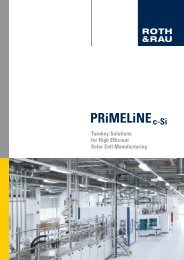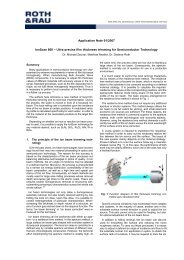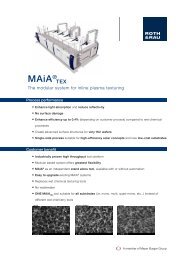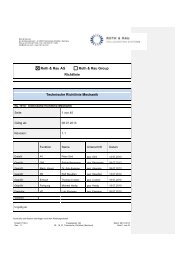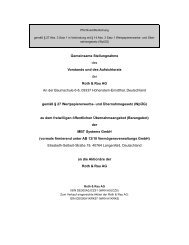PRiMELiNE - Roth & Rau AG
PRiMELiNE - Roth & Rau AG
PRiMELiNE - Roth & Rau AG
Create successful ePaper yourself
Turn your PDF publications into a flip-book with our unique Google optimized e-Paper software.
<strong>PRiMELiNE</strong><br />
Turnkey Solutions by <strong>Roth</strong> & <strong>Rau</strong><br />
Key features:<br />
Short substrate edge leading<br />
Layer stack facing upwards<br />
Cycle time < 60 s<br />
Integrated substrate heating<br />
Selectable composition of CdCl 2 -solution<br />
Closed-loop waste water reconditioning<br />
Integrated exhaust filtration<br />
Safety housing<br />
Automatic cleaning routines for<br />
easy maintenance..<br />
Cascade Washing/ Cascade Rinsing tool<br />
After deposition and tempering of the CdCl 2 layer all remaining<br />
residues are removed in a cleaning step so that the substrates<br />
can be processed in subsequent process steps without any<br />
risk of CdCl 2 contamination to tools and operators. The cascade<br />
washing machine is the final tool within performing the activation<br />
process.<br />
DI-water is applied stepwise on all substrate surfaces utilizing<br />
the eponymous "cascade"-setup of cleaning modules. The procedure<br />
is performed without adding any chemical additives to the<br />
rinse water. After removal of the CdCl 2 layer the substrates are<br />
automatically transferred to an integrated drying section where<br />
liquid film is evaporated. All used DI-water is collected and recycled<br />
on tool level.<br />
Activation Furnace<br />
In close combination with the coating tool the activation furnace<br />
supports the restructuring of the CdS / CdTe layer stack.<br />
After CdCl 2 coating the substrate enters the furnace where<br />
the glass pane is heated up to a defined and well controlled<br />
activation temperature.<br />
Temperature and transport speed are adjustable. Subsequent<br />
to the tempering process the substrate is cooled down carefully<br />
in order to avoid that thermal stress remains inside the<br />
glass. All mentioned steps are performed under standard<br />
atmospheric conditions.<br />
Key features:<br />
Long substrate edge leading<br />
Layer stack facing upwards<br />
Cycle time < 60 s<br />
Atmospheric process<br />
Activation temperature @ app. 400 °C<br />
Activation time adjustable between 10 - 20 min<br />
Integrated cooling tunnel<br />
Integrated filtration of exhaust gases - no special<br />
contaminated exhaust duct system necessary<br />
Safety housing







